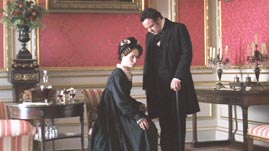Teachers' Domain - Digital Media for the Classroom and Professional Development
User: Preview


Source: MASTERPIECE: "Jane Eyre"


MASTERPIECE is funded by Viking River Cruises, with additional support from public television viewers, and contributors to The Masterpiece Trust, created to help ensure the series’ future.
In this video segment from the 2007 MASTERPIECE adaptation of Charlotte Brontë's Jane Eyre, we get a glimpse of Jane's remarkable ability to stand up for herself and against injustice. Her aunt, Mrs. Reed, summons Jane and tells her, "You have deliberately made it impossible for me to love you." Despite her aunt's fury, Jane responds quite calmly, "You have not tried very hard…and on the day you die, God will know who's telling the truth, whatever you or I say now." Exasperated, her aunt decides to send Jane away to boarding school, run by the heartless Mr. Brocklehurst. During her interview with Mr. Brocklehurst, Jane proves herself to be not only courageous, but clever as well. When asked what she must do to avoid going to hell—the fate of "disobedient, deceitful girls"” when they die—Jane replies, spiritedly, "I must take care to keep in good health and not to fall ill, sir." Mr. Brocklehurst is appalled at her impudence. He asks her again if she is a "deceitful girl." Jane insists, "I am not a liar."
Charlotte Brontë: Biography (Document)
Jane Eyre by Charlotte Brontë: Chapter IV (Document)
Jane Eyre has remained one of the most popular novels in English literature. An instant success, it has been in print constantly since its publication in 1847. Although some 19th century critics criticized Jane—shocked by her outspoken opinions, her disregard for class hierarchy, and her independence—audiences through the years have embraced her wholeheartedly. In her essay, "The Continuing Appeal of Jane Eyre,” Virginia Woolf wrote, “As we open Jane Eyre once more, we cannot stifle the suspicion that we shall find her world of imagination as antiquated, mid-Victorian, and out of date as the parsonage on the moor….So we open Jane Eyre and in two pages every doubt is swept clean from our minds.”
In addition to the beauty of Charlotte Brontë’s prose, her masterful combination of mystery and romance, and her keen eye for setting, it is Jane herself who is responsible for the legion of fans. She was an unusual heroine at the time, neither pretty nor rich nor sweet-natured. And yet it is precisely because she is poor, plain, and defiant that we cheer her on. From the very first time we meet her, we see her bullied by her nasty cousin John, unjustly accused, rejected, and unloved by all. Our sympathies are immediately engaged. We also learn that she has a habit of “taking up her elders” (speaking “truth to power” in modern parlance) and has a passionate commitment to being honest. Her courage inspires us, and we delight in her ability to challenge those who treat her badly.
Just as in the book, the filmmakers capture Jane’s irrepressible spirit early on. We immediately know that she is an outsider, that those around her treat her cruelly, and that she refuses to be a victim of her circumstances. When Mrs. Reed tries to blame Jane for being unlovable, Jane calmly refutes her. “You have not tried very hard [to love me],” she says, and then has the audacity to tell her aunt, “…God will know who is telling the truth, whatever you or I say now.” To emphasize Jane’s innocence, we see the latter part of the scene almost entirely from Jane’s perspective, with the adult characters at a threatening and dominating angle. This scene is a pivotal one. It not only propels the story forward, it reveals Jane’s quick thinking, intelligence, even a sly sense of humor. We know she will not mend her ways at Lowood School, but we are on her side all the way. Jane Eyre may be full of the trappings of an earlier era, but it is Jane’s personality and perseverance that has kept her story fresh and compelling for each generation.
Since its publication in 1847, Jane Eyre has never been out of print. Its heroine—plain but fiercely intelligent, mistreated but outspoken—is one of the most enduring characters in classic English literature. This segment helps us understand that even as a small child, Jane is an appealing character. Despite the hardships and humiliations she endures, she is quick, smart, honest, and self-confident. Although Charlotte Brontë grew up within the limits of Victorian society, she was able to create a character that students can relate to today.
Before watching the video:
While watching the video:
After watching the video:
For more about how MASTERPIECE can help you use film in the classroom, see the MASTERPIECE Teacher’s Guides where you will find the guide, Film in the Classroom, Revised. You might also want to use the resources available in the Jane Eyre Book & Film Club.
 Loading Standards
Loading Standards